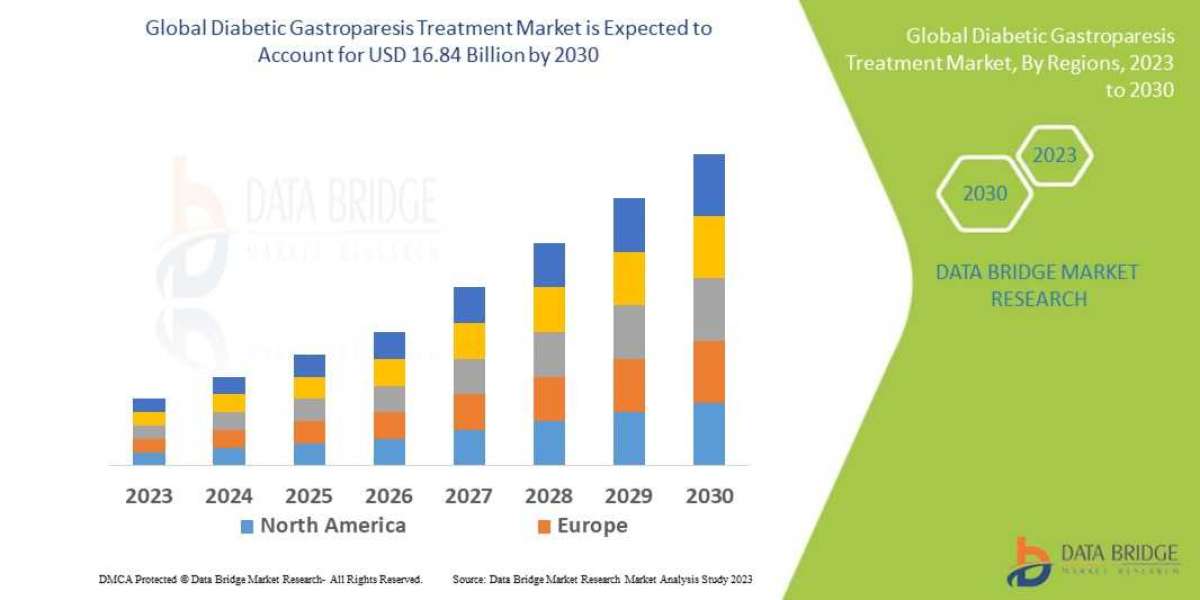Diabetic Gastroparesis Treatment Market – Industry Trends and Forecast to 2030
Global Diabetic Gastroparesis Treatment Market, By Indication Type (Compensated Gastroparesis, Gastric Failure), Treatment (Medication, Surgery), Drugs (Gastroprokinetic Agents, Antiemetic Agents, Botulinum Toxin, Others), Route of Administration (Oral, Injectable), End-Users (Hospitals, Homecare, Specialty Clinics, Others), Distribution Channel (Hospital Pharmacies, Retail Pharmacies, Others) – Industry Trends and Forecast to 2030.
Access Full 350 Pages PDF Report @
https://www.databridgemarketresearch.com/reports/global-diabetic-gastroparesis-treatment-market
**Segments**
- **Treatment Type:** The diabetic gastroparesis treatment market can be segmented based on treatment type into medication (prokinetic agents, antiemetic agents, antibiotics), surgery (gastric electric stimulation, jejunostomy), and other therapies (acupuncture, psychotherapy).
- **Distribution Channel:** The market can also be segmented by distribution channel, including hospital pharmacies, retail pharmacies, and online pharmacies.
- **End-User:** The end-user segment of the market includes hospitals, specialty clinics, and homecare settings.
- **Region:** Geographically, the market can be segmented into North America, Europe, Asia-Pacific, Latin America, and the Middle East and Africa.
**Market Players**
- Medtronic
- Kimberly-Clark Corporation
- Abbott
- Boston Scientific Corporation
- C. R. Bard, Inc.
- Rhythm Pharmaceuticals, Inc.
- Evoke Pharma, Inc.
The diabetic gastroparesis treatment market is witnessing significant growth due to the increasing prevalence of diabetes globally. As the number of diabetic patients rises, the incidence of diabetic gastroparesis, a common complication of diabetes characterized by delayed gastric emptying, is also increasing. This trend is driving the demand for effective treatment options in the market. The segmentation based on treatment type allows healthcare providers to offer a diverse range of therapies tailored to individual patient needs. Prokinetic agents such as metoclopramide and domperidone are commonly prescribed to improve gastrointestinal motility in diabetic gastroparesis patients. Surgical interventions like gastric electric stimulation are recommended for patients with refractory symptoms. Additionally, alternative therapies such as acupuncture and psychotherapy are also gaining traction as complementary treatment options.
When considering the distribution channels, hospital pharmacies play a crucial role in providing immediate access to prescription medications for patients admitted for acute care. Retail pharmacies cater to the outpatient population, ensuring continuity of treatment post-hospital discharge. The emergence of online pharmacies has further enhanced accessibility to diabetic gastroparesis medications, offering convenience and cost-effectiveness to patients. In terms of end-users, hospitals remain the primary point of care for managing diabetic gastroparesis complications. However, specialty clinics specializing in gastrointestinal disorders and homecare settings are increasingly serving as alternative healthcare delivery platforms for long-term management and monitoring of diabetic gastroparesis patients.
Geographically, North America dominates the diabetic gastroparesis treatment market due to the high prevalence of diabetes in the region. The presence of key market players, advanced healthcare infrastructure, and favorable reimbursement policies further contribute to the market growth in North America. Europe follows closely behind, driven by the rising awareness about diabetic complications and the adoption of innovative treatment approaches. The Asia-Pacific region shows immense market potential with a large diabetic population in countries like India and China. Collaborations between pharmaceutical companies and healthcare providers in emerging markets are anticipated to boost market expansion in these regions.
For more information, please visit: https://www.databridgemarketresearch.com/reports/global-diabetic-gastroparesis-treatment-marketThe global diabetic gastroparesis treatment market is experiencing a notable upsurge propelled by the escalating diabetic population worldwide. With diabetes becoming increasingly prevalent, the incidence of diabetic gastroparesis, a complication characterized by delayed gastric emptying, is correspondingly on the rise. This surge in cases is fostering a heightened demand for efficacious treatment options within the market. The segmentation based on treatment type facilitates healthcare providers in catering to a diverse array of therapies specifically tailored to meet individual patient requirements. Prokinetic agents such as metoclopramide and domperidone are frequently administered to enhance gastrointestinal motility in patients afflicted with diabetic gastroparesis. Surgical interventions like gastric electric stimulation are often recommended for individuals experiencing refractory symptoms, offering a more invasive yet potentially effective treatment avenue. Furthermore, non-traditional therapies including acupuncture and psychotherapy are gaining traction as supplementary treatment alternatives, augmenting the range of options available to patients seeking relief.
The distribution channels within the market play a pivotal role in ensuring the accessibility of diabetic gastroparesis medications to the target population. Hospital pharmacies serve as critical points of access for patients requiring immediate medication for acute care management. Retail pharmacies cater to the outpatient demographic, ensuring a continuity of treatment post-hospital discharge and facilitating ease of medication procurement for long-term therapy. The advent of online pharmacies has revolutionized the landscape by providing patients with enhanced convenience and cost-effectiveness in acquiring diabetic gastroparesis medications, underscoring the evolving dynamics of pharmaceutical distribution channels in the current market scenario. When considering the end-user segment, hospitals continue to serve as primary care facilities for addressing complications arising from diabetic gastroparesis. However, the emergence of specialty clinics specializing in gastrointestinal disorders and the increasing emphasis on homecare settings signify burgeoning opportunities for diversified healthcare delivery modalities aimed at facilitating the comprehensive management and monitoring of diabetic gastroparesis patients.
Geographically, North America stands at the forefront of the diabetic gastroparesis treatment market owing to its high prevalence of diabetes and robust healthcare infrastructure. The region also benefits from the presence of key market players and supportive reimbursement policies, further catalyzing market growth. Europe closely follows suit, driven by a growing awareness of diabetic complications and the adoption of cutting-edge treatment paradigms. The Asia-Pacific region holds immense potential for market expansion, particularly in countries like India and China, where a sizable diabetic population presents lucrative opportunities for market penetration. Collaborative initiatives between pharmaceutical entities and healthcare providers in emerging markets are poised to further stimulate market growth, paving the way for enhanced treatment accessibility and improved patient outcomes.
In conclusion, the global diabetic gastroparesis treatment market is on a trajectory of steady growth, propelled by the escalating prevalence of diabetes worldwide and the consequential rise in diabetic gastroparesis cases. The market's segmentation based on treatment type enables healthcare providers to cater to a spectrum of therapeutic interventions, ranging from medications to surgical procedures and alternative therapies. Distribution channels play a pivotal role in ensuring widespread access to treatment options, with hospital pharmacies, retail pharmacies, and online platforms collectively shaping the pharmaceutical landscape for diabetic gastroparesis medications. The diverse end-user landscape encompassing hospitals, specialty clinics, and homecare settings underscores the evolving dynamics of healthcare delivery aimed at providing comprehensive care to diabetic gastroparesis patients. Geographically, North America leads the market due to its robust healthcare infrastructure and high diabetic prevalence, with Europe and the Asia-Pacific region presenting substantial growth opportunities driven by increasing awareness and collaborative initiatives within the healthcare sector. The market's trajectory is marked by innovation, collaboration, and a focus on patient-centric care, setting the stage for continued expansion and advancement within the diabetic gastroparesis treatment landscape.**Segments**
- **Global Diabetic Gastroparesis Treatment Market, By Indication Type (Compensated Gastroparesis, Gastric Failure), Treatment (Medication, Surgery), Drugs (Gastroprokinetic Agents, Antiemetic Agents, Botulinum Toxin, Others), Route of Administration (Oral, Injectable), End-Users (Hospitals, Homecare, Specialty Clinics, Others), Distribution Channel (Hospital Pharmacies, Retail Pharmacies, Others) – Industry Trends and Forecast to 2030.**
The market segmentation of the diabetic gastroparesis treatment industry enables a comprehensive understanding of the diverse dynamics shaping this sector. The indication types, such as Compensated Gastroparesis and Gastric Failure, categorize patients based on the severity of their condition, allowing for tailored treatment approaches. The treatment modalities encompass medication and surgery options, reflecting the spectrum of interventions available to patients, from pharmaceutical management to more invasive procedures like gastric electric stimulation. The range of drugs utilized, including gastroprokinetic agents and botulinum toxin, highlights the varied therapeutic strategies employed in managing diabetic gastroparesis. The route of administration, be it oral or injectable, further adds granularity to the market segmentation by delineating the preferred method of drug delivery for optimal treatment outcomes. End-users, comprising hospitals, homecare settings, and specialty clinics, provide insights into the diverse healthcare facilities catering to diabetic gastroparesis patients, each offering unique benefits in the treatment continuum. The distribution channels, including hospital pharmacies and retail pharmacies, underscore the accessibility of medications to patients, with online platforms revolutionizing the procurement process and enhancing patient convenience in obtaining essential treatments.
The diabetic gastroparesis treatment market is poised for substantial growth and innovation, driven by the increasing global prevalence of diabetes and its associated complications. The industry's segmentation strategy empowers healthcare providers to deliver personalized care through a spectrum of treatment options tailored to individual patient needs. As advancements in pharmaceuticals, surgical techniques, and alternative therapies continue to evolve, the market is witnessing a transformative shift towards more effective and patient-centric approaches to managing diabetic gastroparesis. With a focus on improving outcomes and enhancing quality of life for patients, the segmentation framework provides a roadmap for optimizing treatment strategies and ensuring optimal healthcare delivery across different care settings.
In conclusion, the diabetic gastroparesis treatment market's segmentation based on indication type, treatment modalities, drugs, route of administration, end-users, and distribution channels offers a comprehensive view of the industry landscape. The diverse market segments provide valuable insights into the nuanced complexities of managing diabetic gastroparesis and highlight the innovative approaches driving advancements in treatment options and patient care. By understanding the unique characteristics of each segment, healthcare providers, pharmaceutical companies, and other stakeholders can collaborate effectively to address the increasing burden of diabetic gastroparesis globally. As the market continues to expand and evolve, leveraging these segmentation insights will be crucial in driving future growth, fostering innovation, and ultimately improving the lives of individuals affected by diabetic gastroparesis through enhanced treatment modalities and healthcare delivery mechanisms.
Table of Content:
Part 01: Executive Summary
Part 02: Scope of the Report
Part 03: Global Diabetic Gastroparesis Treatment Market Landscape
Part 04: Global Diabetic Gastroparesis Treatment Market Sizing
Part 05: Global Diabetic Gastroparesis Treatment Market Segmentation by Product
Part 06: Five Forces Analysis
Part 07: Customer Landscape
Part 08: Geographic Landscape
Part 09: Decision Framework
Part 10: Drivers and Challenges
Part 11: Market Trends
Part 12: Vendor Landscape
Part 13: Vendor Analysis
Diabetic Gastroparesis Treatment Key Benefits over Global Competitors:
- The report provides a qualitative and quantitative analysis of the Diabetic Gastroparesis Treatment Market trends, forecasts, and market size to determine new opportunities.
- Porter’s Five Forces analysis highlights the potency of buyers and suppliers to enable stakeholders to make strategic business decisions and determine the level of competition in the industry.
- Top impacting factors major investment pockets are highlighted in the research.
- The major countries in each region are analyzed and their revenue contribution is mentioned.
- The market player positioning segment provides an understanding of the current position of the market players active in the Personal Care Ingredients
Browse Trending Reports:
Nanowires Market
Fiber Optics Components Market
Sleep Apnea Oral Appliances Market
Industrial Cloud Platform Market
Protein Hydrolysates Market
Hospital Acquired Infection Control Market
Industrial Nitrogen Market
Iot Sensors Market
Foliar Spray Market
Iptv Market
Polyphenylene Market
Battery Energy Storage System Market
Portable Battery Pack Market
Medical Electrodes Market
Engineering Plastics Market
Night Vision System And Driver Monitoring System Market
Block Chain In Manufacturing Market
Termite Bait Systems Market
Coated Fabric Market
Flexible Semi Rigid Ureteroscopy Market
Mobile Robots Market
About Data Bridge Market Research:
Data Bridge set forth itself as an unconventional and neoteric Market research and consulting firm with unparalleled level of resilience and integrated approaches. We are determined to unearth the best market opportunities and foster efficient information for your business to thrive in the market. Data Bridge endeavors to provide appropriate solutions to the complex business challenges and initiates an effortless decision-making process.
Contact Us:
Data Bridge Market Research
US: +1 614 591 3140
UK: +44 845 154 9652
APAC : +653 1251 975














